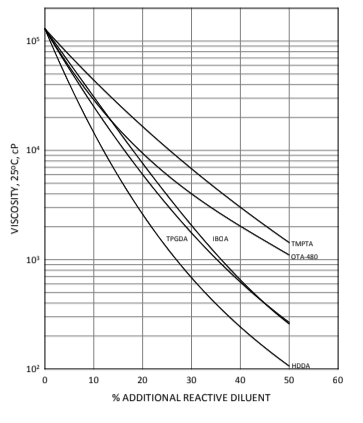Enhanced TDS
Identification & Functionality
- Blend
- No
- CASE Ingredients Functions
- Chemical Family
- Function
- Binder
- Product Code
- MITM00406
- Single Ingredient
- Yes
- Technologies
- Product Families
Features & Benefits
- CASE Ingredients Features
- Performance Highlights
EBECRYL® 438 is characterized by:
- Good pigment wetting
- Good lithography behavior
- Fast UV cure response
UV cured products containing EBECRYL® 438 are characterized by the following performance properties:
- Good adhesion to metals, plastics and paper
The actual properties of UV/EB cured products also depend on the selection of other formulation components such as reactive diluents, additives and photoinitiators.
Applications & Uses
- Application Method
- Coating End Applications
- Compatible Substrates & Surfaces
- Cure Method
- Ink & Toner End Applications
- Markets
- Applications
- Product Applications
Formulated UV curable products containing EBECRYL® 438 may be applied via lithographic, screen, gravure, direct or reverse roll, and curtain coating methods. EBECRYL® 438 is recommended for:
- Wet lithographic inks for paper, plastics, and metals
- Promoting adhesion for coatings on metal, plastics and paper
- Overprint varnishes applied by lithography
- Post-formable inks
Properties
- Physical Form
Technical Details & Test Data
- Typical Tack Ranges
Oligomer / Reactive diluent Tack, g-m Condition EBECRYL® 438 19-21 400 RPM, 90°F, 3 minutes; Thwing-Albert Electronic Inkometer
EBECRYL® 438 / 5% OTA-480 16-18 400 RPM, 90°F, 3 minutes; Thwing-Albert Electronic Inkometer
EBECRYL® 438 / 10% OTA-480 8-10 400 RPM, 90°F, 3 minutes; Thwing-Albert Electronic Inkometer
EBECRYL® 438/ 5% TPGDA 14-16 Tripropylene glycol diacrylate, product of allnex.
EBECRYL® 438 / 10% TPGDA 6-8 400 RPM, 90°F, 3 minutes; Thwing-Albert Electronic Inkometer
- Viscosity Reduction
- Graph I shows the viscosity reduction of EBECRYL® 438 with 1,6-hexanediol diacrylate (HDDA) of allnex, isobornyl acrylate (IBOA) of allnex, propoxylated glycerol triacrylate (OTA-480), trimethylolpropane triacrylate (TMPTA), and tripropylene glycol diacrylate (TPGDA) of allnex.
- Although viscosity reduction can be achieved with non- reactive solvents, reactive diluents are preferred because they are essentially 100 percent converted during UV/EB exposure to form a part of the coating or ink, thus reducing solvent emissions.
- The specific reactive diluents used will influence performance properties such as hardness and flexibility. Graph II illustrates the change in viscosity of EBECRYL® 438 with increasing temperature.
Graph I: Viscosity Reduction With Reactive Diluent

Graph II: Viscosity Vs. Temperature

Packaging & Availability
- Packaging Type
Principal Information
- Group Principal Number
- S000001
- Principal
Storage & Handling
- Storage Conditions
- Care should be taken not to expose the product to high temperature conditions, direct sunlight, ignition sources, oxidizing agents, alkalis or acids.
- This might cause uncontrollable polymerization of the product with the generation of heat. Storage and handling should be in stainless steel, amber glass, amber polyethylene or baked phenolic lined containers.
- Procedures that remove or displace oxygen from the material should be avoided. Do not store this material under an oxygen free atmosphere.
- Dry air is recommended to displace material removed from the container. Wash thoroughly after handling. Keep container tightly closed. Use with adequate ventilation.
Other
- Appearance
- Clear liquid
- Appearance (SDS)
- Clear liquid
- Color (SDS)
- Clear pale yellow
- Insoluble in (SDS)
- Water
- Item Number
- Odor (SDS)
- Ester like
- Other Hazards
- Polymerization may occur from excessive heat, contamination or exposure to direct sunlight .
- Protect from Freezing
- Yes
- Temperature Control
- Yes
- USA/DOT UN Number
- Not Applicable
- Chemical Properties
Value Units Test Method / Conditions Acid Value max. 25.0 mg KOH/g mg KOH/g - Material Composition
Value Units Test Method / Conditions Oligomer Content 60.0 - - Optical Properties
Value Units Test Method / Conditions Color Scale max. 5.0 Gardner Gardner Gardner Color Scale - Physical Properties
Value Units Test Method / Conditions Density 1.26 g/mL g/mL At 25°C Storage Temperature 39.2-104.0 °F °F Viscosity 1350.0-1650.0 cPs cPs At 60°C - SDS Physical and Chemical Properties
Value Units Test Method / Conditions Boiling Point (SDS) min. 100.0 °C °C Density (SDS) 1.28 g/cm³ g/cm³ Vapor Pressure (SDS) max. 1.33 - at 20°C Volatile Content (SDS) max. 0.3 % % - Shelf Life & Stability
Value Units Test Method / Conditions Shelf Life 0.0 -
